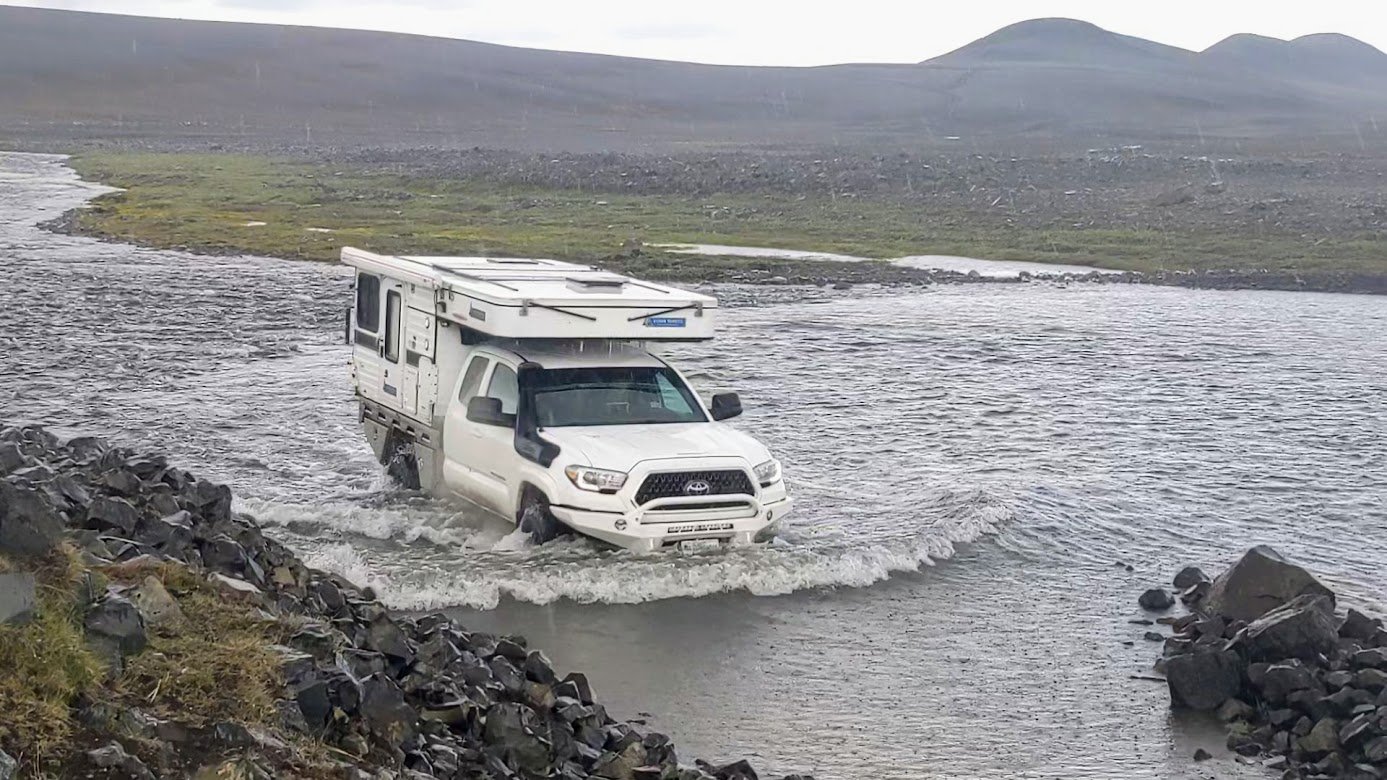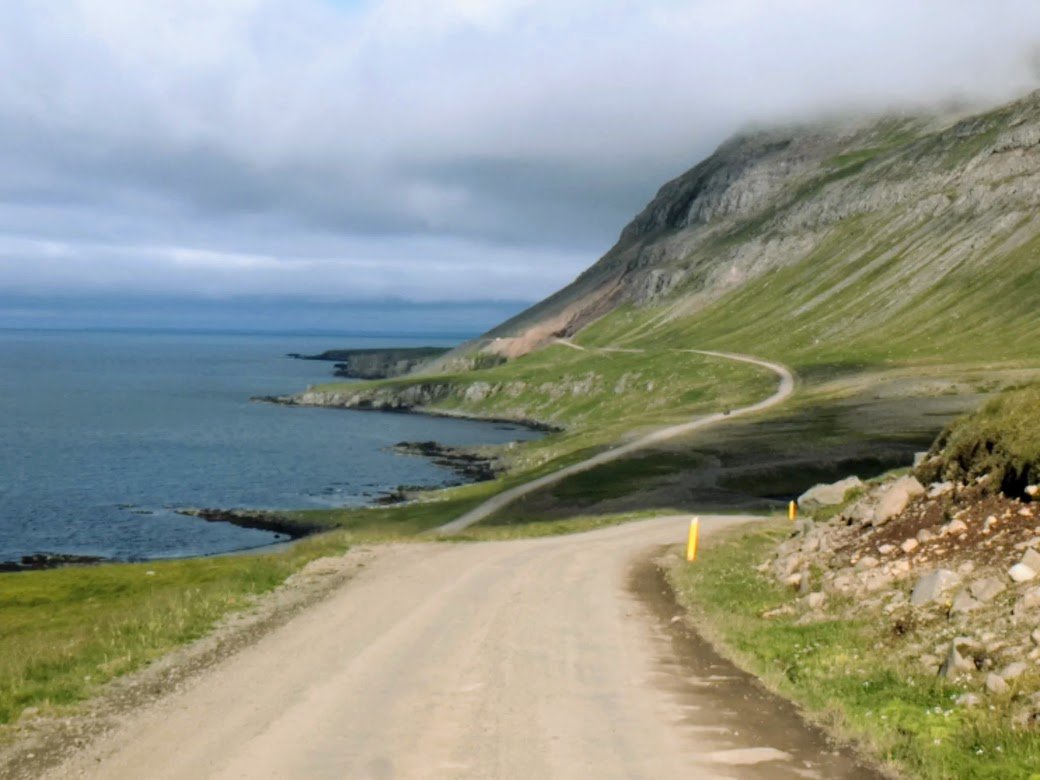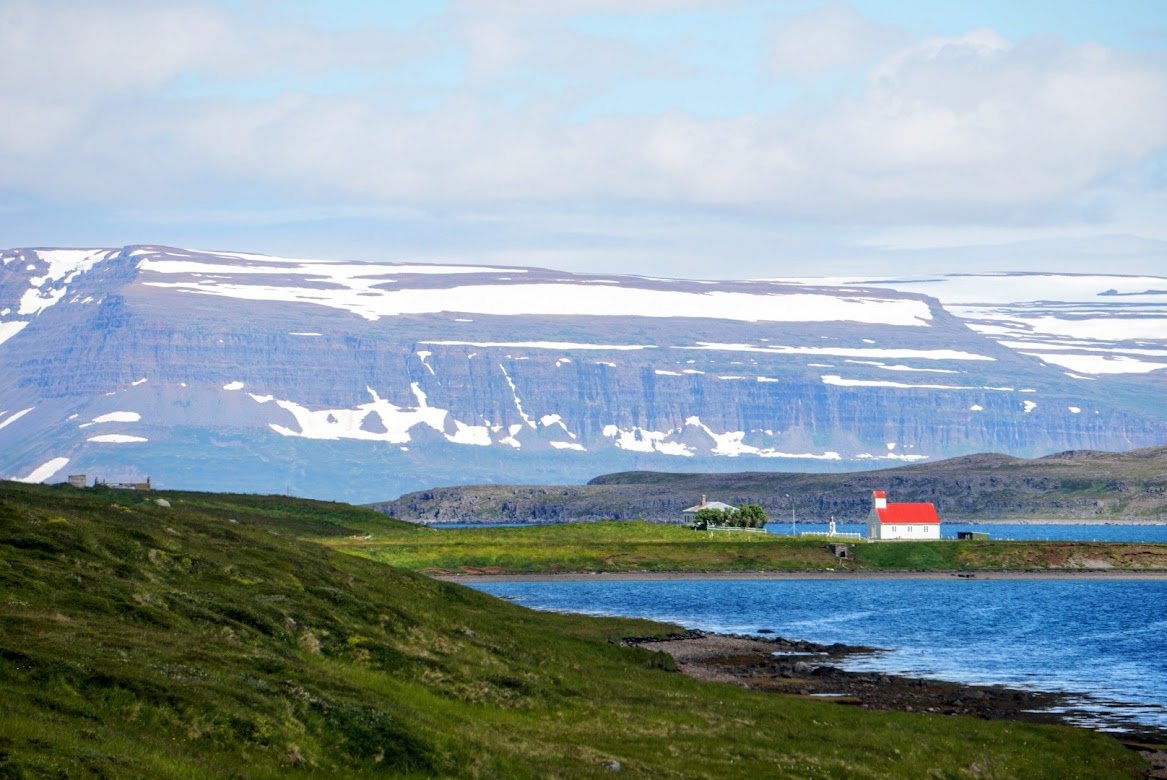Iceland - Part 2 - Vatnajökull National Park, North and West Coasts
Our journey continues! Iceland is a natural wonderland, with landscapes varying day after day, adventures around every steep coastal curve or at the end of jarring volcanic bumpy roads.
Highlights for the Second Half of our Iceland Trip - 12 days
Borgarfjörður Eystri - best up-close puffin watching
Vatnajökull National Park - drive to Askja Crater loop with F910, F905, F88
Westfjords - especially the Þingeyri peninsula drive
Second half of our Iceland route, 1300 miles, 40 hours of driving in 12 days
Continuing North from Egilsstaðir on the east coast
Dawn had been laser-focused on pursuing intimate puffin experiences, so our next stop was a town with a reputedly large nesting puffin colony. Rumors turned out to be completely true.
Borgarfjörður Eystri
One word: Puffins! Although touristy, we had our best puffin watching here. There is a large parking area with a café, restrooms, viewing platforms and stairs out on the small bluff which was literally covered in puffins. (We were there in mid July.) We were able to stand and watch them a few feet away and they seemed totally oblivious to people snapping pictures like the most avid paparazzi.
An Aside on Puffins
A quick rundown on what we found: we opted early on not to pay for a tour or visit an offshore island. (That budget thing again, always watching it.) We found nesting puffins in three places: Borgarfjörður Eystri on the east coast, hiking Rauðanes Point in the north east, and Látrabjarg cliffs in the Westfjords. At Rauðanes Point we saw one, half way through our 5 mile walk along the cliffs, but we were not looking hard. We were able to sit and watch it within a few feet for quite a while until it got bored and flew off. At Látrabjarg cliffs you could see them close to the parking area and along the 8 miles of cliff trails. It was not nearly as crowded with people as Borgarfjörður Eystri, but the concentration of puffins was not as high either. Three different and lovely experiences with these enchanting birds. They do not seem interested in engaging with humans, but they are certainly not afraid of us or concerned by our proximity which makes them fun to hang out with.
Vatnajökull National Park
Satiated with puffin love (for Dawn), it was time for Andy to have fun with the 4x4. We set off on a three-day excursion into the highlands, travelling a loop connecting the F910, F905 and the F88. We spent our ninth and tenth nights camping at Kverkjökull glacier and Askja crater. No gas stations in the highlands of the park so we gassed up at the last station in Möðrudalur.
Bumping our way across lava beds
Beautiful, bleak volcanic panoramas
We found it somewhat amusing but understandable that we were stopped and welcomed into the park on three separate occasions by rangers. Friendly staff just making sure that we were not entertaining ideas of taking off freewheeling across the landscape or setting up a remote camp somewhere.
River crossing - not serious on the F905 or F910
Ranger station and facilities at Kverkjökull campground in the national park, 2000isk per person, with shower and toilet facilities
Always the most rugged overlanding vehicles in Iceland
Glacier at Kverkjökull
Heading out to the new lava flow at Holuhraun, the road becomes a light track in the sand
New volcanic spring bubbling out of the black sand
Exploring the new lava field from 2014 eruption at Holuhraun
Our second night in the highlands we made our way to Dreki Campground, close to the hike to Askja crater. We were feeling like we were camping in a moonscape, then found out NASA was on site doing research (they had the red and white Mountain Hardware tents).
Dreki Campsite, near Askja Crater. 2500isk per person
Parking area for Askja crater, hike still mostly under snow in July
Askja Caldera and Viti Lake, often swimmable but currently not advisable because of volcanic activity
River crossing on the F88– one of the more serious ones, the rope marks the shallow route. Boldness be my friend.
Then we popped out into populated tourist areas again, with a stop at Reykjahlíð near Myvatn lake to refill the gas tank then explore nearby geothermal areas.
Hverir - colorful geothermal pools near Myvatn
We had been blessed with more than our fair share of good weather in Iceland, but when we hit Ásbyrgi Canyon the heavens poured.
Ásbyrgi Canyon hike, time for full rain gear
Camp at Ásbyrgi Canyon - 11th night on the road, pleasant grassy sites along the cliff for 2750 isk for two people.
Feeling a little wet and soggy, we made our way to the coast in the hopes of hiking Rauðanes Point, a 5 mile loop on the headlands on the north coast featuring volcanic lava formations offshore. We arrived in drippy fog and were not optimistic about seeing much. We took the opportunity to pop up at the trailhead hoping to see a weather change. With 24 hour light, we were ready and willing to hike late into the evening. In the end we went to sleep. Our 12th night on the road was a rare free night. We spent a quiet night with no traffic on the small road and no company. Then the morning dawned, glorious and sunny again!
Trailhead camp at Rauðanes, free, no facilities
Offshore lava formations at Rauðanes Point - 5 mile loop hike
Northern Coast
Then back on the road, making our way west along the north coast.
Idyllic harbor town of Husavik. Found a great cafe with strong Wifi - The Lókal.
Iconic Husavik church
Goðafoss
It was time to re-provision so our 13th night on the road was outside of the second largest town in Iceland, Akureyri (population a little over 18k). A big jump down from the largest city of Reykjavk with a population of over 130k.
Another sweet depiction of Icelandic sensibilities - a heart-shaped stop sign
Our favorite bargain shopping store in Iceland - the Bonus
Ouch, fill up at $212 for 22 gallons ($9.68 per gallon)
Budget
No discussion of travelling in Iceland is complete without a discussion of budget. Iceland is expensive, the most expensive place we have travelled in terms of basic supplies - like gas and food. We mitigated this by stocking up on non-perishables that we shipped in the truck. Wild camping is illegal and campgrounds charge by the person not the vehicle so it added up for the two of us sharing a budget. On the upside, National Parks and all hiking reserves are free of charge.
Our life is full-time travel, so we economize on items that many people would not if they were heading out for a two week vacation. We rarely eat out or pay for extra tours and admission fees. In Iceland, by far our biggest expense was gas. This was exacerbated by the fact that our truck is not an economy vehicle (it inhales gas) and we moved on every single night. In the end we spent close to $70 a day on gas (YIKES). Our second biggest expense was food at $26, mostly for groceries with a few restaurants and bakeries thrown in. But then, Andy eats a lot. Our third biggest daily expense was camping, at an average of $17 per day for the two of us. Other expenses were minimal.
We came with two full propane tanks (2 1/2 gallons each), knowing that refills are not legal or possible in Iceland (the only other countries so far we have not been able to refill are Finland and Moldova). Despite the cold and periodically running our heater, we only used up one tank. This was probably helped by the fact that we never heated water for showers since we were using campgrounds.
We have never paid for electricity or water in our close to two years of living in the truck and this carried over into Iceland. Water was readily available in campgrounds. We have two solar panels and a rechargeable lithium battery and power has never been an issue for us (even with one of our two solar panels breaking on us which has happened twice.)
Camping Hamrar outside of Akureyri, 3800isk for two of us, showers included, full of vacationing Icelandic families
With a bonus hike up the cliffs leaving from the campsite to view the town and valley below
We left Akureyri with everything we needed to complete the trip and set off to drive the Tröllaskagi peninsula. It was a scenic wonderland with huge snow-covered mountains and towns squeezed along narrow bands of flatter ground between the mountain base and the water.
Vistas from the Tröllaskagi peninsula
14th night on the road, municipal campground at Skagastrond before entering the Westfjords. Busy place, grassy field, 1500isk per person, and laundry facilities which we needed.
Westfjords
The following day took us into one of the most scenic and remote coastal areas of Iceland - the Westfjords. The first day we took a stunning drive out to the small village of Djúpavík. With Icelandic ingenuity, the old herring factory had been transformed into an art gallery.
Village of Djúpavík - herring factory now an art gallery
The setting gave the modern art an extra atmospheric bonus
Inside the old fish oil tank
Abandoned trawler on the shore
Road to Djúpavík
Then a bonus second free camping night, along a shore road with no traffic. Ocean views and fire ring included. Not a legal campground but no one bothered us. We had also been told by a local that there are exceptions to the no wild camping rule, that if you were tired you were allowed to pull off the road and sleep, a vague loop hole.
Iconic Icelandic color scheme: blue water, green hills, mountains with patches of snow and white buildings with red roofs
We spent an evening wandering around Ísafjörður with its dramatic mountain backdrop. We appreciated finding a cafe with wifi (which had become our favorite town experience in Iceland). In general, cell coverage was decent in Iceland, except for the highland areas. But Wifi at campgrounds was mostly weak or non-existent so we would try to find a cafe or bakery with Wifi to do things like download photos.
Ísafjörður in the Westfjords
Colorful architecture
For our 16th night, we found a gorgeous campground 8 miles out of Ísafjörður, Korpadular camping. It was much less crowded than the site on the outskirts of town where people were within a few feet of each other. Spacious grassy area with toilets and a shower. 1700isk per person
Had a lovely time conversing with Elmira, a LIthuanian dancer who fell in love with Iceland on an Erasmus year and had returned to work locally for the summer.
Þingeyri Peninsula
We stumbled into this drive that became one of our favorites in Iceland. We started driving the first part of the route which is established and has reputed beauty. Then we reached the “undeveloped jeep track” section and the warning signage and decided to just keep going. So glad we did.
Cliff-hugging dirt road
Stellar sweeping views with turquoise water
Rock overhangs along the water
We came off the drive awestruck by its beauty and variety, (which the perfect weather definitely helped) and continued working our way around the Westfjords.
Dynjandi waterfall - you can see it for miles, hard to capture its immense scale.
17th night on the road at Reykjarfjarðarlaug - free camping with hot pools, awesome. Except for the 30 Icelandic youths with their speaker system partying until 3am. Oh well, who needs sleep. Apparently only old people.
The site had a combination of wild geothermal pools and this developed larger pool right on the ocean, beautiful.
The next drive was out the magnificent Arnarfjörður road, with the added bonus of visiting the home of Icelandic sculptor Samuel Jonsson.
Home of artist Samuel Jonsson, 1884-1969
Samuel Jonsson’s sculpture garden. In addition to his lion fountain, in the background is his depiction of Leif Ericson, Icelandic explorer reputed to be the first European to land on the Americas in the late 10th century.
Enjoying the variety of views along the Westfjords
Then our final puffin stop at Látrabjarg, Eight miles of hiking along the dramatic cliffs.
The correct position for puffin watching, belly down right at the cliff edge.
Drive out to Látrabjarg
A note on Icelandic Art and Culture
The benefits of camping in our own vehicle are that we control our own space and pace, but we do sometimes miss having more interaction with the people in the countries we visit. We find connection in the random conversations with fellow campers both local and visitors and learn as much as we can. In our experience, Icelanders are a little kooky, adventurous, practical and yet at the same time have a quirky artistic side. We saw this in the art, the architectural decorations and the business slogans.
When driving, we listen to audible books. When possible, we listen to a book from or about the country we are travelling in. We spent most of our time in Iceland listening to Independent People, a book recommended by a friend. A novel by Icelandic Nobel laureate Halldór Laxness, it was originally published in 1934 and details the often tragic struggles of Bjartur, a sheep farmer and his family in the 1930’s. It was not our favorite book, we found it often difficult to empathize with the main character, a stubborn and idealistic man. However, as is often the case with books that may not resonate at the time you are reading it, parts of it stuck with us throughout our time, and we kept coming back to it. We would remember the houses Bjartur built as we walked through the countryside and saw the ruins of old homes. But it also brought home the deep thinking artistic side of the Icelandic culture. Despite his commitment to a minimalist lifestyle, Bjartur wrote and spoke poetry, it was an important part of his life. The language of the book itself was elegant and lyrical. One scene in which the family is called outside by the son to wonder at and admire the bloom of a single dandelion on their land resonated with both of us. Life was hard but moments of beauty were still appreciated. This theme was repeated throughout the culture and the art we experienced in the country.
Kleifabúi on Kleifaheiði heath, stone man erected in 1947 by the road construction workers. Worked on after hours for the benefit and joy of passersby.
Monument to The Unknown Bureaucrat by Magnús Tómsson. So many ways to interpret this . . .
18th night on the road. Barðastrandarvegur, idyllically situated right by the beach, 1500isk per person, spacious grassy area. Listened to the waves all night.
West Coast
We left the Westfjords, the realization of our time in Iceland coming to a close looming large as we made our way south back to Reykjavik.
Washing the insidious sticky red dirt off the truck, appreciating the free car wash stations at key locations in Iceland
Colorful town of Stykkishólmur
Snæfellsjökull National Park
Our final stop, the peninsula reputed to have everything Iceland is known for in one compact area. Ocean beaches, mountains, volcanic craters, lava fields, gorges and glaciers, it is all there. We were running out of time so had a quick day to knock out some highlights, knowing we were likely not doing it justice, but our truck had an appointment with a ship the next day.
We spent our 19th night on the road at Hellissandur, conveniently close to the national park, 1700isk per person with showers included.
Snæfellsjökull National Park, most western tip - we saw whales!
Skarðsvík Beach. Complete with Viking grave site.
Path to Djúpalónssandur beach through lava formations
We spent a final, 20th night on the road in a municipal camp north of Reykjavik. Simple and uncrowded, with a view of the valley below.
Camp Mosfellsbaer, 1000isk per person, simple campsite 20 minutes outside of Reykjavik, great value.
So long Iceland, you have given us terrific memories. From amazing scenery, to fending off protective arctic terns with walking poles, drives just challenging enough to get the adrenaline activated and lovely people and surprising art along the way, it has been an inspiring time.
We are going to hole up in a hotel in Brussels and wait for the truck to follow us by ship so we can resume our overland travels.
As always, thank you for reading, we appreciate your support. And let us know if we can answer any questions!








































































